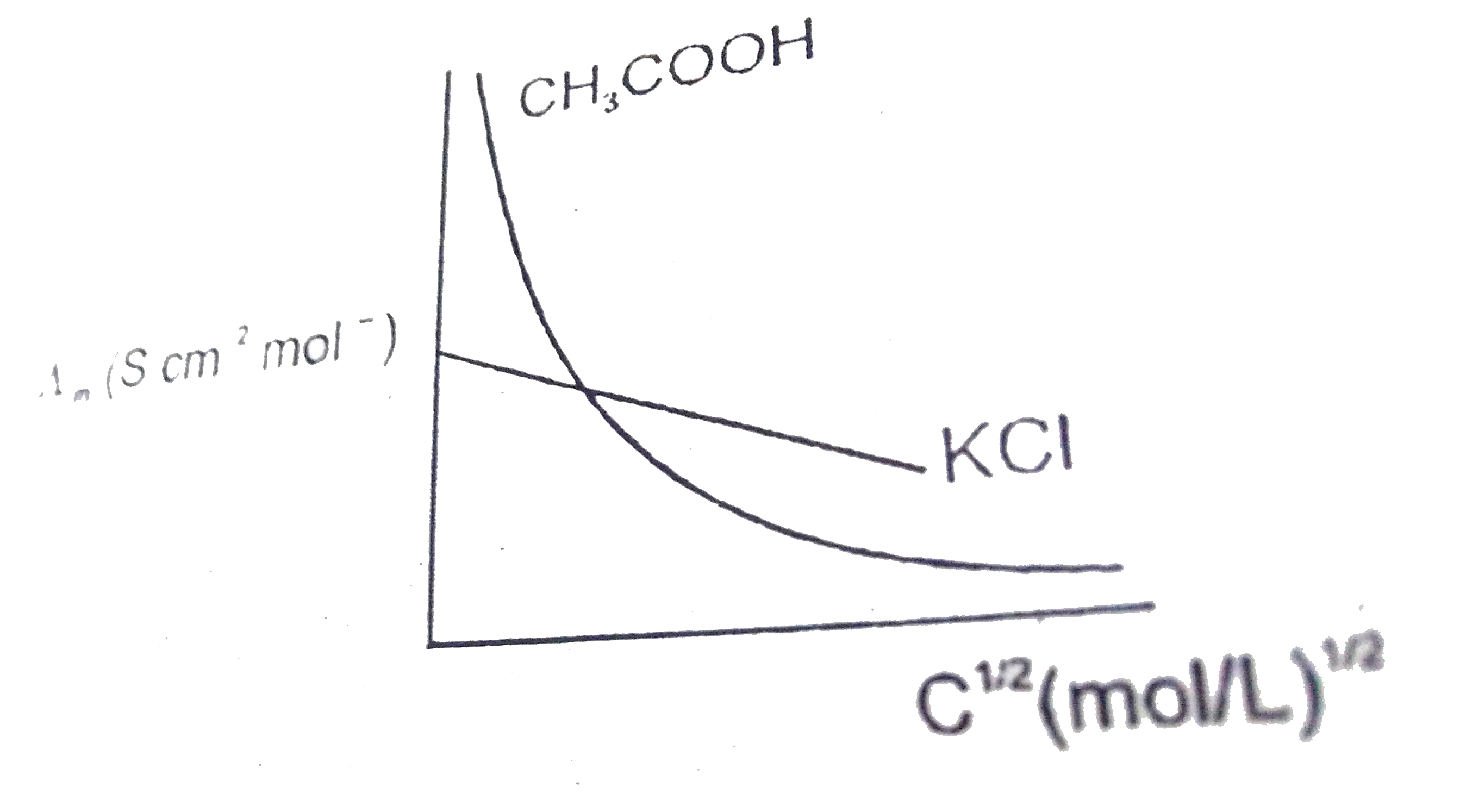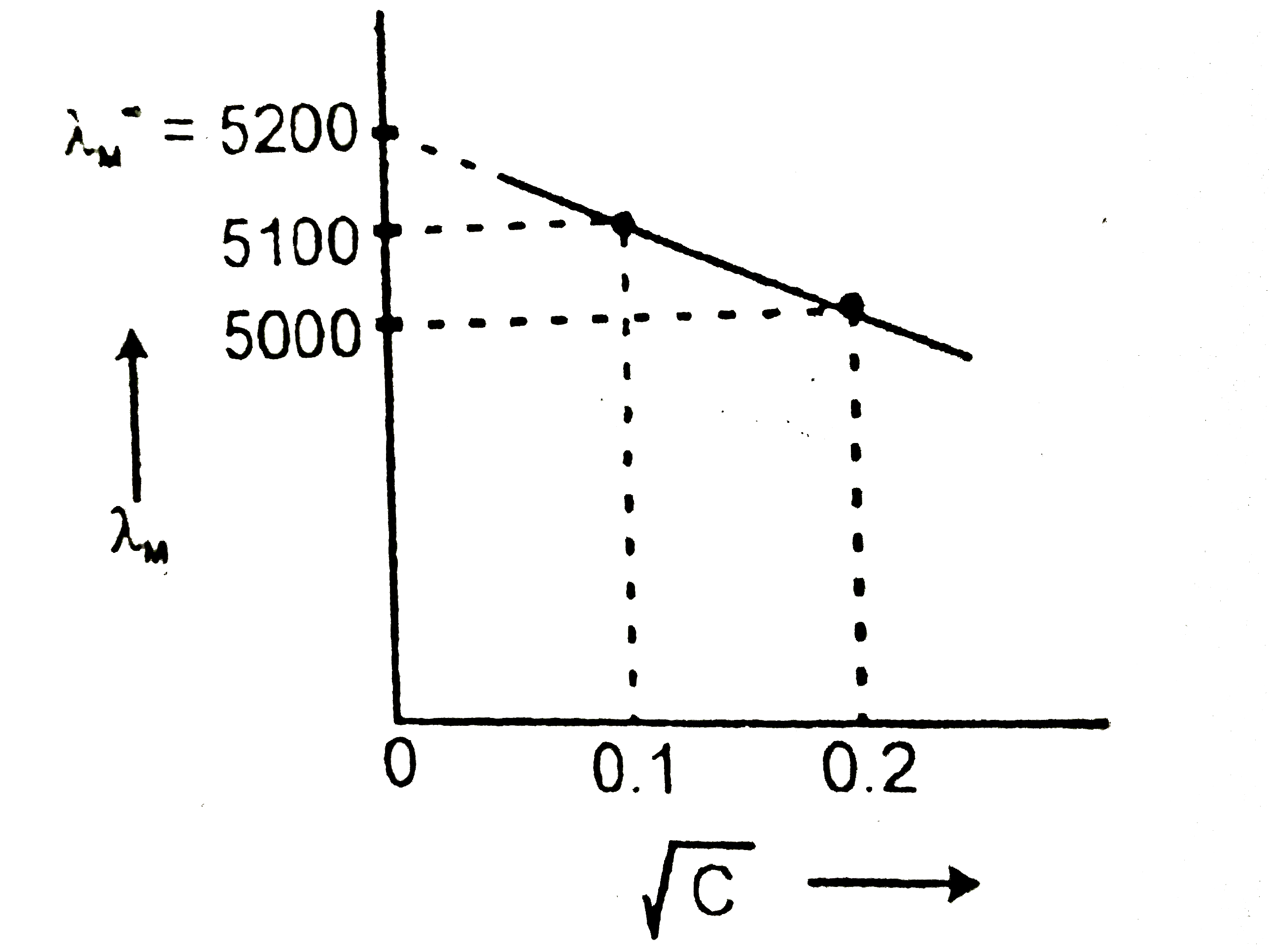Definie conductivity and molar conductivity for the solution of an electrolyte. Discuss their variation with concentration.
Conductivity: the inverse of resistivity is called conductivity (or specific conductance). It is denoted by K (greek, kappa)
K=1ρ
its SI unit is Sm−1 or Ohm−1m−1
Molar conductivity: molar conductivity of a solution is defined as the conductance of the solution which contains one mole of the electrolyte such that the entire solution is placed between the two electrodes kept one centimetre apart. it is denoted by ∧m (greek lambda)
∴ Molar conductivity ∧m=KC
Variation of molar conductivity with concentration: molar conductivity ∧m versus concentration C1/2 for acetic acid (weak electrolyte) and potassium chloride (strong electrolyte) in aqueous solution is shown below:

Topper's Solved these Questions
- ELECTROCHEMISRYBOOK - RESONANCE ENGLISHCHAPTER - ELECTROCHEMISRYEXERCISE - Advanced Level Problems
88 Videos
- ELECTROCHEMISRYBOOK - RESONANCE ENGLISHCHAPTER - ELECTROCHEMISRYEXERCISE - Part 2
23 Videos
- ELECTRO CHEMISTRYBOOK - RESONANCE ENGLISHCHAPTER - ELECTRO CHEMISTRYEXERCISE - PHYSICAL CHEMITRY (ELECTROCHEMISTRY)
53 Videos
- EQUIVALENT CONCEPT & TITRATIONSBOOK - RESONANCE ENGLISHCHAPTER - EQUIVALENT CONCEPT & TITRATIONSEXERCISE - Part -IV
22 Videos
Similar Questions
Define conductivity and molar conductivity for the solution of an electrolyte. Discuss their variation with concentration.
View Solution(a) Define the terms conductivity and molar conductivity for the solution of an electrolyte.
Comment on their variation with temperature
(b) The measured resistance of a conductance cell was 100 ohms. Calculate (i) the specific conductance and (ii) the molar conductance of the solution
(KCl=74.5gmol−1 and cell constant =1.25 cm−1)
View Solution
Knowledge Check
Limiting molar conductivity of NaBr is
AΛ∘mNaBr=Λ∘mNaCl+Λ∘mKBrBΛ∘mNaBr=Λ∘mNaCl+Λ∘mKBr−Λ∘mKClCΛ∘mNaBr=Λ∘mNaOH+Λ∘mNaBr−Λ∘mNaClDΛ∘mNaBr=Λ∘mNaCl−Λ∘mNaBr
Define molar conductance
View SolutionExpress the relation between.conductivity and molar conductivity of a solution.
View SolutionResistivity is reciprocal of molar conductivity of electrolyte.
View SolutionThe molar conductivity of strong electrolyte
View Solution(a) Apply Kohlrausch law of independent migration of ions, write the expression to determine the limiting molar conductivity of calcium chloride.
(b) Given are the conductivity and molar conductivity of NaCI solutions at 298 K at different concentrations :

Compare the variation of conductivity and molar conductivity of NaCI solutions on dilution. Give reason.
(c) 0.1 M KCI solution offered a resistance of 100 ohms in conductivity cell at 298 K. If the cell constant of the cell is 1.29cm−1, calculate the molar conductivity of KCI solution.
View Solution
At 0.04 M concentration the molar conductivity of a solution of a electrolyte is 5000Ω−1cm2mol−1 while at 0.01 M concentration the value is 5100Ω−1cm2mol−1 making necessary assumption (taking it as strong electrolyte) find the molar conductivity at infinite dilution and also determine the degree of dissociation of strong electrolyte at 0.04M.
View SolutionAt 0.04 M concentration, the molar conductivity of solution of an electrolyte is 5000Ω−1cm2mol−1 while at 0.01 M concentration the value is 5100Ω−1cm2mol−1. Making necessary assumption (Taking it as strong electrolyte) find the molar conductivity at infinite dilution and write percentage dissociation of strong electrolyte at 0.04 M.
View Solution
